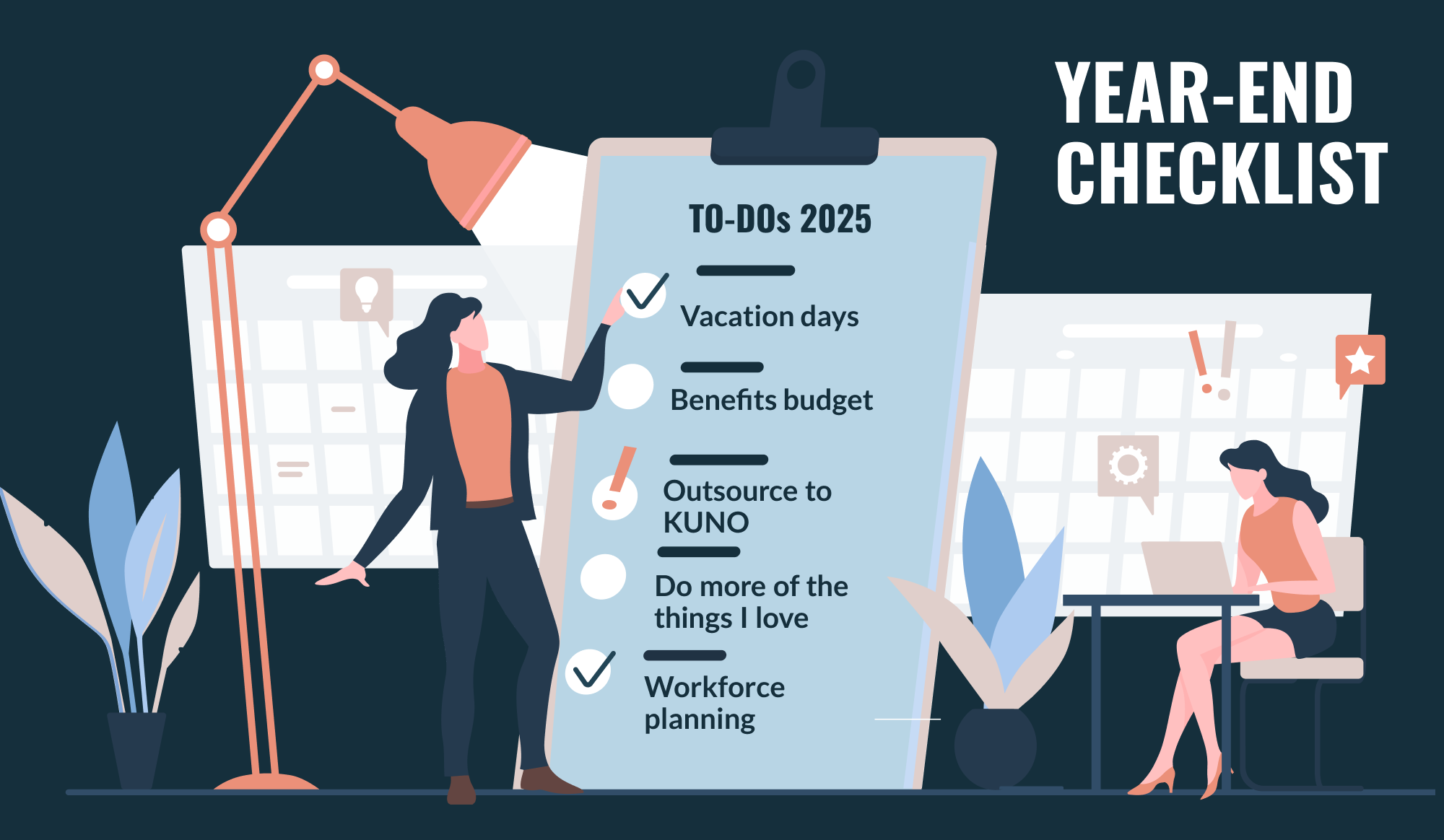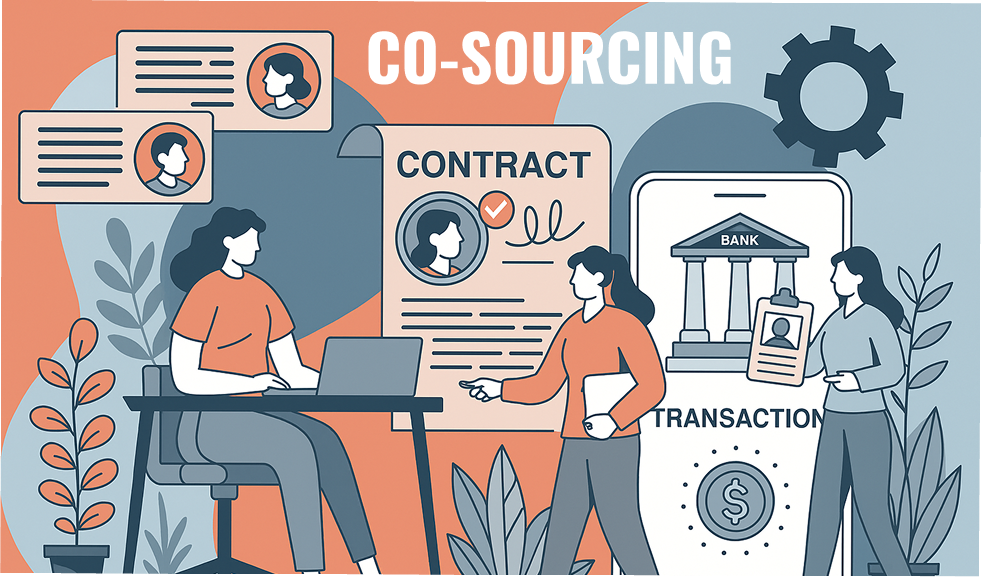Year-End Sprint in HR & Payroll – What Matters Most for 2025
As the year draws to a close, the HR and payroll departments enter one of their busiest phases. While many teams are finalizing projects or preparing for holidays, HR & Payroll are focused on reviewing data, meeting deadlines, updating systems, planning budgets, and setting the course for the upcoming year.
Working with structure now not only ensures a smooth year-end but also lays the foundation for a more strategic and efficient 2026. This article highlights key topics to review — including deadlines, current thresholds, practical examples, and strategic insights.
1. Planning Bonuses and Special Payments on Time
December is traditionally the month for bonuses and special payments — from annual bonuses and holiday pay to inflation compensation payments. These should be clearly defined and recorded in the payroll system before the end of the year.
The “principle of receipt” applies: payments employees earn for 2025 must be made within 2025 to be taxed in that year. If payments are made in January, they fall under the following tax year and may trigger higher deductions.
Practical example: The bonus payment is postponed to January 2026 to conserve liquidity. However, this often leads to confusion among employees and a higher tax burden since the payment is allocated to the following year. Early coordination between Finance and Payroll — along with clear communication — helps prevent such issues.
Quick check:
- Identify all bonus and special payments
- Coordinate payout dates with Finance and Payroll
- Inform employees transparently about timing and amounts
From a strategic perspective, it’s advisable to integrate bonus mechanisms into the HR budget and benefits planning for 2026 (see point 8) to ensure long-term consistency and transparency.
2. Reviewing Outstanding Vacation Days and Carryover Rules
Vacation balances are often overlooked — until January arrives and the numbers raise questions. Under German labor law, unused vacation days must generally be taken by March 31, 2026, unless otherwise agreed or carried over due to exceptional cases such as parental leave, illness, or collective agreements.
Practical example: In January, it’s discovered that significantly more vacation days than expected have been carried over into the new year. This leads to additional coordination between HR, Payroll, and Finance and to higher vacation accruals in financial accounting. Such unplanned accruals can impact the annual results. A reconciliation in December helps maintain transparency and avoid surprises.
Tip: Generate a vacation report from the HR system, coordinate with team leads, and inform employees about remaining days. Planning vacation for Q1 2026 early also helps manage coverage and avoid scheduling conflicts.
Pro tip: Set a reminder before March 31, 2026 to check again which vacation days have actually been taken. Proactively inform employees that unused days expire after this date — this prevents misunderstandings and avoids unnecessary questions later on.
3. Reviewing Tax-Free and Flat-Taxed Benefits Before Year-End
As part of year-end closing, companies should not only check regular payroll items but also tax-relevant additional benefits. These include tax-free allowances (e.g., for energy, commuting, or meals) as well as flat-taxed benefits, such as vouchers, gifts, or team events.
These benefits must be accurately recorded in the payroll system by year-end and, if applicable, reported to the tax advisor to ensure proper allocation in the annual accounts. In Germany, such benefits may fall under flat-rate taxation (§ 37b German Income Tax Act) if they exceed certain limits.
Organizations handling payroll internally or via external providers should pay particular attention here — retroactive corrections in the new year are time-consuming but can easily be avoided through early coordination.
Conclusion: Reviewing all tax-free and flat-taxed benefits at the end of the year improves transparency, minimizes post-year adjustments, and helps determine which benefits to maintain or optimize in 2026.
4. Social Security and Tax Thresholds for 2026
Starting January 1, 2026, new contribution thresholds apply to Germany’s statutory social security system. These are particularly relevant for employees with higher salaries and affect payroll calculations nationwide.
Unified nationwide

Companies employing staff across multiple German regions should ensure both values are configured in their payroll systems. For remote or hybrid teams, it’s essential that the employee’s actual place of employment is correctly recorded, as this determines which regional threshold applies.
Employees with earnings near these limits should be proactively informed, as their contributions may slightly change — this transparency helps prevent confusion in January.
5. Reviewing Changes to Mini Jobs and Mid-Range Jobs
Several key parameters for marginal employment (known as Mini Jobs and Midi Jobs in Germany) will change at the turn of 2026. The statutory minimum wage will increase to € 13.90 per hour, which in turn raises the Mini Job income limit to an expected € 603 per month.
Employers should check existing Mini Job contracts — especially those with fixed working hours — and adjust them if needed. It may also be worth reassessing whether certain temporary, support, or project-based roles should continue under this arrangement.
With the higher Mini Job threshold, the Mid-Range Employment Bracket (Midi Job) — where employees pay reduced social security contributions — will also shift upward. Some employees previously classified as Mini Jobbers may now fall into this category, requiring adjustments in payroll and reporting.
Practical example: It is determined that due to the higher minimum wage and slightly increased working hours, several employees will move into the Midi Job category in 2026. Adjusting contracts ahead of time ensures these changes are accounted for and prevents payroll corrections later on.
Conclusion: Reviewing contracts, working hours, and system configurations in December saves time in January and helps avoid compliance issues.
6. Cleaning Up HR and Payroll Systems
Year-end is the perfect moment to tidy up your systems — not as a theoretical audit, but as a practical clean-up. Over the year, HR Information Management Systems and payroll databases often accumulate incomplete or outdated records.
Now is the time to check:
- Are all relevant employee details complete and up to date?
- Are there information fields or sections rarely used that can be simplified or removed for the new year?
- Should internal structures or data categories be updated to make systems leaner and more efficient?
It’s also worth reviewing data retention and deletion policies: Which personal records must be deleted, and which must be archived for compliance reasons? Regular reviews prevent unnecessary data storage, ensure compliance with data protection laws (e.g., GDPR), and reduce long-term storage and admin costs.
Conclusion: This clean-up creates order, clarity, and data security. It saves time in the coming year and ensures HR and Payroll start 2026 with accurate and reliable data — a small investment with a big impact.
7. Preparing for the Pay Transparency Act and 2026 Reporting
Companies with more than 50 employees should begin preparing for the requirements of Germany’s Pay Transparency Act (Entgelttransparenzgesetz). Its goal is to ensure equal pay for work of equal value — and from 2026, many organizations will be required to provide corresponding documentation or reports.
Now is the time to:
- Review pay, function, and qualification data
- Define clear reporting processes
- Align responsibilities between HR, Finance, and Legal
This effort pays off twice: a solid data foundation not only simplifies reporting but also strengthens transparency toward employees.
Note: The Pay Transparency Act will be further detailed over the coming months and will bring new obligations for many companies. In one of our upcoming blog posts, we’ll explore this topic in depth — including the key legal updates, compliance requirements, and practical recommendations for HR and payroll teams.
To make sure you don’t miss this article, sign up for our KUNO newsletter to receive new updates and insights directly via email.
Conclusion: Plan early rather than catching up later — building structures now saves time, reduces risk, and builds trust.
8. HR Budget and Benefits Planning for 2026
To start the new year with structure, HR budget planning should happen now, not in spring. HR and Payroll are closely tied to Finance — investments in people, learning, and engagement only make an impact if they’re prepared in advance.
The planning process should cover:
- Base pay and variable compensation, such as bonuses and performance-based pay
- Learning and development budgets (e.g., for training programs, mentoring, or learning platforms)
- Onboarding and software costs, which often rise as teams grow
- Practical, everyday benefits, such as meal subsidies, anniversary bonuses, or small recognition awards
Recurring costs like recruiting platforms, licenses, and coaching services should also be realistically evaluated. Short-term decisions, such as introducing new benefits or training programs “on impulse,” often lead to budget overruns or underuse.
Practical example: During the year, a decision is made to introduce a training budget without allocating funds in advance. Since no budget was reserved, the initiative can only be implemented the following year. Early alignment between HR and management ensures such programs can be realized and effectively used.
Conclusion: Proactive budgeting creates financial clarity and decision-making confidence. It’s the foundation for realistic resources and clear priorities going into 2026.
9. Employee Communication and Year-End / Kick-Off Discussions
At the end of the year, communication with employees is just as important as process management. Genuine dialogue builds trust, motivation, and engagement.
Depending on internal processes, year-end or annual kick-off meetings can take place at different times. What matters is that they’re integrated into a structured feedback or development cycle. These meetings are opportunities to reflect, share feedback, and set individual goals.
Helpful guiding questions include:
- What went well during the past year or cycle — and why?
- Which projects or tasks were most impactful?
- Where is there potential or a desire for growth?
- What should be prioritized in 2026?
Beyond formal discussions, recognition is key. A personal message or brief one-on-one shows employees their contributions are valued — whether as part of a team meeting or in direct conversation.
Conclusion: Feedback and development conversations aren’t a formality — they’re a key leadership tool. They strengthen trust, motivation, and alignment, providing employees with a clear sense of direction for the new year.
10. HR Roadmap and Workforce Planning 2026
The turn of the year is the ideal moment to organize priorities and gain a clear overview of projects and resources. An HR roadmap connects strategic planning with operational execution — ensuring that 2026 begins with focus rather than chaos.
It should outline which projects will be addressed, when, and by whom. This may include:
- HR projects: reviewing or redesigning feedback processes, adjusting benefits, updating internal policies, improving recruiting, or launching learning initiatives
- Payroll projects: evaluating external providers, restructuring processes, standardizing interfaces, or enhancing reporting
- Process improvements: unifying communication channels, creating templates, or updating documentation and knowledge bases
A good roadmap prioritizes projects realistically, defines timelines, and assigns responsibilities within the team. This prevents overlaps and ensures resources are used effectively.
Workforce planning is equally essential: Which roles will be needed in 2026? What skills are missing? Which succession plans should be defined? How can current employees be developed further?
It’s also worth evaluating which topics can be handled internally and where external support may be beneficial — for example, in complex projects, temporary capacity gaps, or specialized HR and payroll topics. In such cases, Co-Sourcing can be an effective solution to integrate external expertise flexibly without overloading internal teams.
For a closer look at how Co-Sourcing works and what advantages it offers, see our separate blog post on this topic.
A clear people and resource plan builds long-term security, clear responsibilities, and prevents bottlenecks in critical areas.
Conclusion: A well-structured HR roadmap consolidates all key areas — HR, payroll, and workforce — into one actionable plan. It creates focus, transparency, and accountability for the entire year ahead.

Closing Thoughts for a Strong Year-End and New Year Start
Those who use the year-end period strategically will start 2026 with clarity, structure, and momentum.
The transition between years is the perfect opportunity to review HR and Payroll processes — from workflows and systems to budgets and responsibilities.
Many of our clients begin the year with a short HR or Payroll Audit, helping identify areas for optimization and set clear priorities for the months ahead.
👉 If you’d like to prepare your organization for a strong start into 2026, we’re happy to support you with a structured analysis or a tailored kick-off workshop.
Reach out to us or book a meeting directly — and let’s build a solid foundation for your success in 2026.







